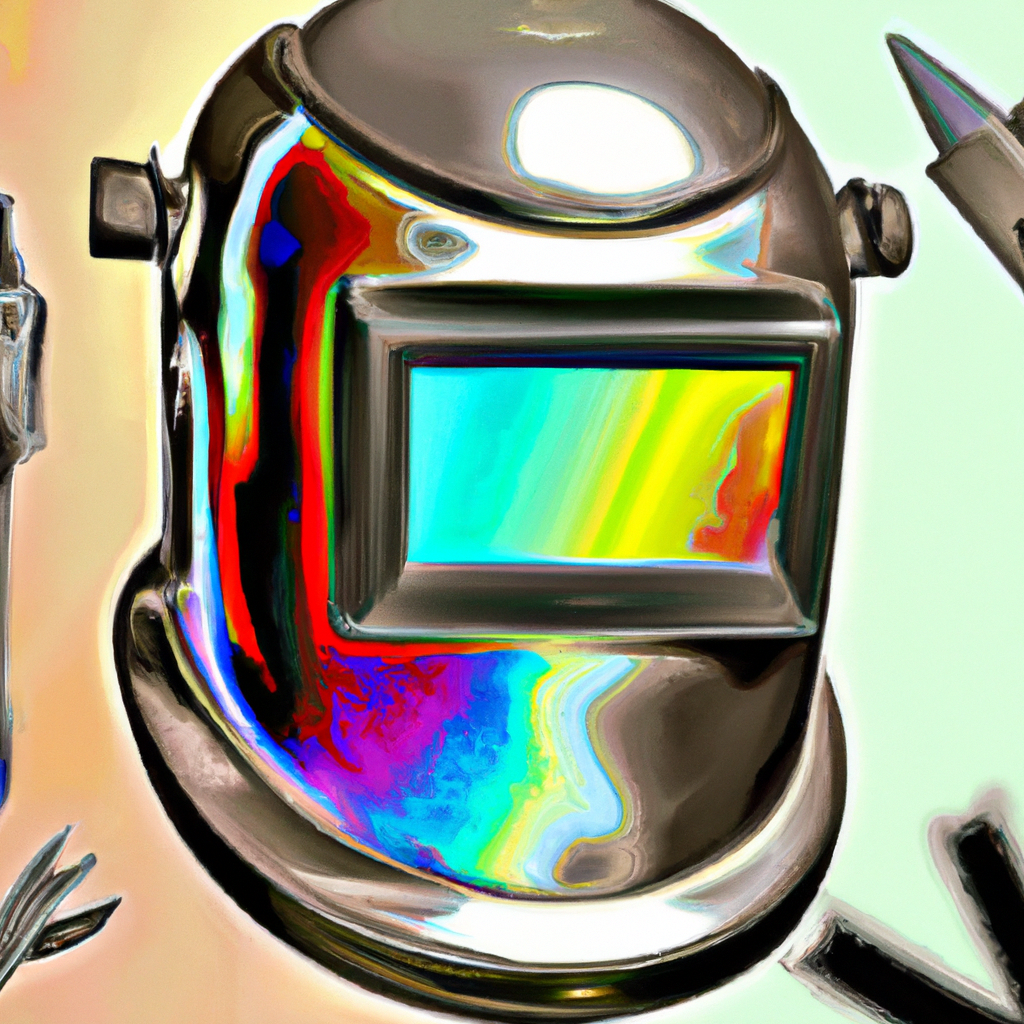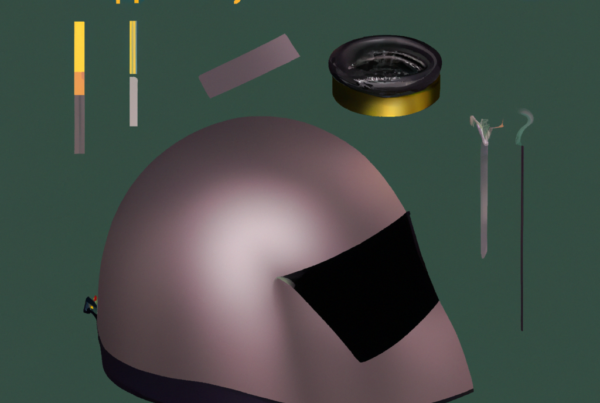Welding is an essential process in manufacturing and construction, but it can be dangerous to the eyes and face. It’s important to protect yourself with the right gear, and a welding helmet is an absolute must. But why does your welding helmet flash? This is a sign that the lens inside is reacting to the ultra-violet and infrared light emitted during the welding process, and is changing from a clear state to a darkened state to protect your eyes. By understanding why your welding helmet flashes, you can ensure that you work safely and efficiently.

What is the purpose of a welding helmet?
A welding helmet is a critical piece of safety equipment for welders. It is designed to protect the face, head, and neck from exposure to extreme heat, sparks, and ultraviolet radiation that are generated during the welding process. It also helps to protect against eye damage that can be caused by looking directly at the intense light generated by the welding arc.
The welding helmet is composed of a face shield and a hood. The face shield is designed to cover the eyes, nose, and mouth and protect them from injury or burns. The hood is designed to protect the head and neck from sparks and molten metal. The helmet also features a darkening lens that is designed to protect the eyes from the intense light generated by the welding arc.
The welding helmet is equipped with a flash-sensing system that monitors the welding arc. When the arc is struck, the helmet will automatically darken the lens to protect the eyes from the intense light. This is why the helmet will sometimes flash when the welding arc is struck.
In summary, the welding helmet is an essential piece of safety equipment for welders. It is designed to protect the face, head, and neck from exposure to extreme heat, sparks, and ultraviolet radiation that is generated during the welding process. The welding helmet is equipped with a flash-sensing system that automatically darkens the lens when the welding arc is struck, which is why the helmet may sometimes flash.
What are the potential problems when a welding helmet flashes?
A welding helmet flashing can be an indication of several issues. The potential problems include:
- Inadequate ventilation – if the welding helmet is not properly ventilated, it can cause the lens to fog up and cause it to flash.
- Low battery – if the battery is low, it can cause the lens to flash.
- Damaged lens – if the lens is scratched, cracked, or otherwise damaged, it can cause the helmet to flash.
- Faulty wiring – if the wiring is defective or corroded, it can cause the helmet to flash.
- Incorrect shade setting – if the shade setting is incorrect, it can cause the helmet to flash.
It is important to properly diagnose the issue to ensure the safety of the welder. If the issue is not addressed, it can lead to eye injury or even blindness. Properly maintained welding helmets and safety equipment should be used to protect the welder from potential hazards.
How does a welding helmet work?
A welding helmet is a type of headgear worn while welding to protect the eyes, face, and neck from sparks, intense light, and heat. The welding helmet’s face shield, made of a high-density plastic and darkened glass, is designed to protect the welder from the intense light created by an electric arc. It also shields the face and neck from flying sparks and molten metal.
When welding, the electric arc is created by the welding current and the helmet’s face shield darkens to protect the welder from the high levels of light. The face shield also has a filter lens, which helps to reduce the amount of ultraviolet and infrared light that passes through. In some helmets, the lens also has a special auto-darkening feature that darkens the lens automatically when the electric arc is created.
In some cases, the welding helmet may flash when the electric arc is created. This is the result of the helmet’s auto-darkening feature, which works to protect the welder from the intense light. The flash is typically very brief and is not harmful to the welder. It is simply an indication that the helmet is working to protect the welder from the light.
What are the common causes of a welding helmet flashing?
Welding helmets are designed to protect the eyes and face of welders from the intense light and heat that is created when welding. However, sometimes the helmet can start to flash, which can be disorienting and dangerous. The most common causes of a welding helmet flashing are:
- Damaged lenses or sensors: If the lenses or sensors on the welding helmet become damaged, it can cause the helmet to flash.
- Improper setting: If the settings on the welding helmet are not adjusted properly, the sensors may be too sensitive, which can cause the helmet to flash.
- Excess dirt or debris: If the lenses on the welding helmet become covered in dirt or debris, this can also cause the helmet to flash.
- Broken wires: If any of the wires inside the helmet become broken, this can cause the helmet to flash.
If your welding helmet is flashing, it is important to diagnose and address the problem quickly. Ignoring the problem can lead to more serious and expensive repairs in the future.
How should you adjust the settings on your welding helmet to prevent it from flashing?
My welding helmet flashes when the settings are too bright. It is important to adjust the settings on your welding helmet to prevent it from flashing. Here are the steps you should take to adjust the settings on your welding helmet:
1. Check the shade number on the helmet. It should range from 8 – 13.
2. Adjust the settings on the helmet to the lowest possible number that still allows you to see the weld.
3. Increase the sensitivity of your helmet. This will help reduce the risk of the helmet flashing.
4. Check the output of the helmet. It should be around 80 (maximum 120).
5. Make sure to adjust the settings on your helmet regularly to ensure the best possible protection.
By following the steps above, you can adjust the settings on your welding helmet to prevent it from flashing. This will help ensure your safety while welding.
Are there any safety concerns related to a welding helmet flashing?
Welding helmets are essential safety equipment designed to protect your eyes and face from sparks, spatter, and harmful ultraviolet and infrared radiation during welding operations. However, a welding helmet can occasionally flash, and this can be a cause for concern.
There are several potential safety concerns related to a welding helmet flashing, such as:
- Exposure to intense ultraviolet and infrared radiation, which can cause eye and skin damage.
- A short circuit or electrical fault, which could cause an electric shock.
- Damage to the welding helmet’s lens, which could impair vision.
- Damage to the welding helmet’s internal components, which could affect its performance.
To ensure your safety, it’s important to identify the cause of the flashing before continuing to weld. Common causes include a short circuit, a defective lens, or a loose connection. In any case, it’s best to stop welding and inspect the helmet before continuing.
What is auto-darkening technology and how does it relate to welding helmet flashing?
Auto-darkening technology is a feature of welding helmets that automatically adjust the level of darkness when welding. It is designed to protect welders’ eyes from the intense light produced during the welding process. It works by sensing the arc light and automatically darkening the lenses in the helmet to a predetermined shade. When the welding stops, the helmet goes back to its original level of tint.
The reason why a welding helmet may flash is due to a malfunction in the auto-darkening technology. This malfunction can be caused by a number of factors, such as:
- Incorrectly calibrated sensors
- Faulty electronics
- Worn-out batteries
- Excessive heat
Fortunately, most of these problems can be solved by simply calibrating the sensors, replacing the batteries, or adjusting the settings. If the flashing persists, it is recommended to seek professional help.
What are the advantages and disadvantages of auto-darkening technology?
Auto-darkening technology is a popular and effective way to protect welders from the bright light that is produced when welding. This technology has many advantages and a few disadvantages.
Advantages of auto-darkening technology include:
- It automatically adjusts to the brightness of the welding arc, which prevents welders from having to adjust their helmets manually.
- It is faster and more efficient than manual adjustment, which can be difficult in some welding scenarios.
- It is safer than manually adjusting a helmet, since it requires less time and effort.
The main disadvantage of auto-darkening technology is that it can be expensive, especially for professional welders. Additionally, some welders may not be comfortable with the level of automation that it provides, which can be a deterrent for some.
Why does my welding helmet flash? The auto-darkening technology in welding helmets is designed to respond to the welding arc. The sensors in the helmet detect the arc and activate the auto-darkening filter, which is what causes the helmet to flash.
How should you maintain and care for your welding helmet to prevent it from flashing?
It is important to maintain and care for your welding helmet to prevent it from flashing. Here are some tips to help:
1. Make sure to adjust the sensitivity and delay settings on the helmet appropriately. Different welding processes require different settings.
2. Check your helmet regularly for any wear or damage. Replace any damaged parts or lenses immediately.
3. Clean the helmet at least once a week. Use a damp cloth to wipe it down and remove any dust or dirt.
4. Store the helmet in a cool, dry place when not in use.
5. Never use solvents or abrasive cloths to clean the helmet as these can damage the lens.
6. Avoid dropping or banging the helmet as this can cause damage.
7. Make sure the welding helmet is not too close to the welding area as this can cause the lens to flash.
Following these tips will help ensure your welding helmet is properly cared for and will reduce the chances of it flashing.
Are Welding Spatter and a Flashing Welding Helmet Related?
Welding spatter is the unwanted splatters of molten metal that can cause defects in a weld, while a flashing welding helmet is designed to protect the welder’s eyes from intense light. Although the two are not directly related, ensuring proper welding techniques and using appropriate shielding gases can assist in the causes and reduction of welding spatter.
What should you do if your welding helmet continues to flash despite your best efforts?
If your welding helmet continues to flash despite your best efforts, there could be a few possible causes. Here are some steps to take to troubleshoot the issue:
- Check the battery: Make sure the battery is charged and properly installed.
- Check the sensitivity settings: Adjust the sensitivity settings to see if that helps stop the helmet from flashing.
- Clean the lens: Clean the lens with a soft cloth or lens cleaner to remove dirt and debris that may be causing the issue.
- Replace the lens: If none of the above steps work, it might be time to replace the lens of the helmet.
If you are still having trouble with your welding helmet flashing, it may be best to contact the manufacturer for further assistance. They may be able to provide additional information to help resolve the issue.



